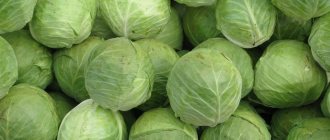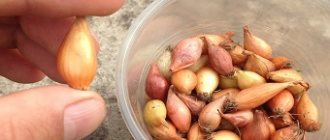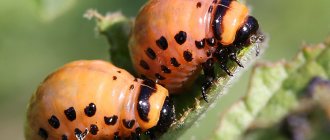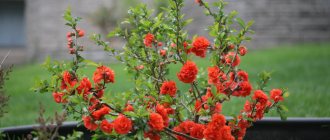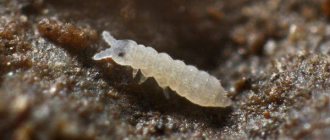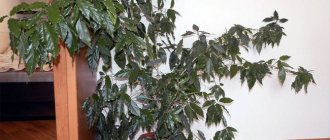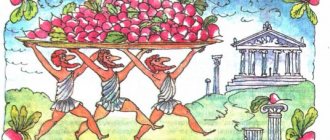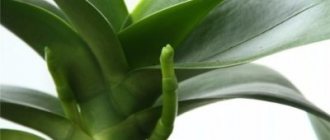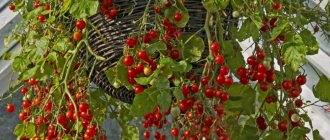Reasons for appearance
Among horseradish pests, horseradish is in first place. This insect also has other names - cabbage leaf beetle, horseradish leaf beetle. In addition to these two crops, babanukha often attacks horse sorrel. These are bugs whose body length is 0.35–0.4 cm. The insects are dark green, shiny in appearance and close in shape to a circle.
Babanukha usually overwinters in the surface layer of the earth, so its appearance is due to the inattention of farmers to neutralize this layer. The emergence to the surface occurs in the spring. The earliest signs of aggression can be noticed on weeds, since the leaf beetle eats them before cultivated plants. The leaves that are eaten are reduced to the state of a skeleton. Every 12 days a new wave of the pest arrives. The leaf beetle is active in cloudy, damp weather. It does not depend on gardeners, of course, but it is recommended to carefully care for the plantings and remove all weeds, which avoids conditions for the appearance of the pest.
It is very important to practice disease prevention. If horseradish is healthy, it resists insects much better. In addition, there is no need to tensely guess what caused the holes or white spots on the plants.
The wavy flea makes holes in the foliage. Tiny arthropods should not put gardeners in a complacent mood. These “miniature” horseradish destroyers can make a kind of sieve out of a strong large leaf in 5–7 days. The insect can be recognized by its dark color and yellow stripes on its back. It is almost impossible to collect them with your hands, since the slightest movement triggers the instinct to jump. The wavy flea overwinters in the ground, so non-compliance with preventive measures should also be considered an indirect cause of its appearance. The insect causes the main damage from the first days after emergence; it develops its highest activity on hot, dry days.
The cabbage moth is also a formidable enemy of the acute plant. This butterfly has a wingspan of 30 mm. It is colored brown; you can see dark stripes on the front parts of the wings. The caterpillars overwinter in the soil, they break out in June, and the formation of cocoons immediately begins. After 10 days, you can expect the most active aggression, when the second generation settles on the leaves. The danger persists for about a month, then the insects begin to prepare for winter again.
Another pest is the cabbage bug. Yellow foliage helps to recognize its invasion. If you do not fight the consequences of infection, it will soon become covered with necrotic spots. The flat red bug with black speckles reaches a length of 80–100 mm. It delivers its main blow against the backdrop of hot weather.
Horseradish diseases control methods
Description of the page: horseradish disease control methods from professionals for people.
Why are horseradish leaves in holes?
There is probably no summer resident who is not familiar with such a plant as horseradish. This cold-resistant perennial plant is widespread throughout Russia and beyond its borders. Horseradish leaves are rich in vitamin C and are actively used in the treatment of diseases such as scurvy. In folk medicine, horseradish leaves are used in the preparation of tinctures that help with joint pain. Based on horseradish leaves, medicines are produced that improve digestion and remove salts from the body.
In addition to being used for medicinal purposes, the leaves and roots of this plant are actively used by housewives for canning and pickling. It is not surprising that the appearance of holes in horseradish leaves causes concern among home garden owners.
This article will help you understand why holes appear on horseradish leaves and how to deal with it.
Who eats horseradish leaves
The main pests of horseradish are the Babanukha beetle and the wavy flea beetle. They are the ones who are able to devour the leaves of the plant, leaving behind holes. These pests love to eat not only horseradish leaves, but also other cruciferous plants. These include cabbage, radishes, rapeseed, turnips and radishes. In this regard, pests easily move around the site from one plant to another.
Babanukha is a black beetle with a greenish tint and brown legs. The beetles overwinter in the remains of vegetation, and with the onset of warmth they begin to actively eat horseradish leaves, because it is one of the first to germinate after winter.
The wavy flea beetle is also a black beetle with a metallic tint, only 3 mm long, which is why it is very difficult to see with the naked eye. Just like the Babanukha beetle, it overwinters in plant debris or dung heaps. In the spring, emerging from shelter, they begin to devour all wild plants of the cruciferous family, including horseradish leaves.
If you do not fight these pests, then over time they will switch to cultivated plants and destroy the crop.
Control measures
One of the effective ways to combat the above pests is prevention. In autumn, it is necessary to remove all plant debris and weeds from the site. In early spring, if signs of pests are detected on horseradish leaves, it is necessary to treat with insecticides.
To treat infected plants, the drugs Fury, Sherpa, Confidor, Bankol, Inta-Vir, Aktelik are used. These drugs effectively fight both pests. They must be used according to the instructions on the drug.
If you do not want to use chemical control measures, then you can use folk remedies. Insect pests of cruciferous crops cannot tolerate the smell of calendula and marigold flowers. Plant these flowers on your property and they will repel pests. To treat plants, many summer residents use an infusion of tobacco leaves and a vinegar solution. The solution is prepared at the rate of 10 liters of water per glass of 9% vinegar. The treatment is carried out in the morning.
Now you know who eats horseradish leaves and how to deal with these pests.
Horseradish diseases: white rust
The causative agent of this horseradish disease is a fungus. The leaves of a plant affected by rust are covered with small pale yellow spots, which are located singly or in groups.
The lower surface of the leaves is covered with whitish shiny pads, which are pustules of the fungus. If after some time the epidermis covering the pads is destroyed, a white powdery mass will fall out, which is the spores of the pathogen.
At the first stage, horseradish affected by white rust becomes deformed, and then the plant dies. There is a lag in the development and growth of the plant.
Plant remains are the place of promise for the fungus in winter.
Sources of white horseradish rust:
- Remains of diseased plants.
- Overwintering infected weeds (colts, shepherd's purse).
- Working with a hoe, the purpose of which is the timely removal of weeds, which, if desired, can be done with the help of hands by pulling out unwanted vegetation by the roots.
- Collection with the obligatory subsequent destruction of the affected plant remains of horseradish.
- Spraying plants twice - a one percent Bordeaux mixture is used (one hundred grams of copper sulfate and lime are taken per 10-liter bucket).
Horseradish can also suffer from other diseases that affect other crops: cercospora blight and black rot.
Ways to combat the most common horseradish pests
Horseradish can often be seen in Russian vegetable gardens. It is famous for its unpretentiousness, but sometimes this crop can be affected by various pests, which are difficult to cope with. Today’s article will talk about the enemies of the plant. Gardeners will also be able to learn how to treat horseradish against pests.
The most common enemies of culture
The plant may die if the cabbage moth spreads. It is a brown butterfly with a 3 cm wingspan. Dark stripes are visible on the front ones. The caterpillars overwinter in the ground, but when they come out at the beginning of summer, they immediately form a cocoon. After a 10-day period, the second generation of pests can be expected to settle. The insects are so aggressive that they can completely destroy a bush in a month.
The cabbage bug is also harmful to horseradish. A sign of its spread is yellowed leaves. Subsequently, necrotic spots can be seen on the infected bush. A bug measuring 8 to 10 cm in size can be identified by its red color with small black spots. The insect shows its main aggression in hot weather.
The plant that most often harms the plant is the cabbage leaf beetle, which is also called the cabbage leaf beetle and the horseradish leaf beetle. It is a bug with a body of 3 to 4 mm, which makes it difficult to see. The pest spreads quickly, eating leaves on the crop. To prevent this, horseradish management is necessary, which involves removing weeds around the bush. The same measure prevents horseradish diseases, which are difficult to cope with.
The wavy flea, which is an arthropod, also harms the crop. This insect spreads quickly. In just a week, it affects the entire bush, turning the leaf plate into a sieve. The insect is dark in color and has yellow stripes on its back. It is difficult to collect fleas because they jump at the slightest danger. Insects winter in the upper layers of the soil, so digging up the area around the bush will help prevent their spread. If this is not done, then with the onset of the hot dry period these horseradish pests become active.
Preventive measures
Pest control is not easy, so you should prevent the spread of pests in advance. To protect horseradish from insects, the following preventive measures must be taken:
- Strictly follow the rules of crop rotation.
- After harvesting time, you need to dig up the soil on the site.
- It is recommended to plant seedlings as early as possible.
- Use safe detergents.
- Disinfect the soil regularly.
If you dig up the area immediately after harvesting, the eggs laid by pests end up in the upper layers of the soil. In winter, they die under the influence of low temperatures, so a new generation of insects is not expected. A mixture of tobacco dust and wood ash will help protect the area. Onion-chamomile decoction, as well as spilling the soil with a solution of laundry soap, also have a similar effect.
You cannot plant tomato seedlings and root crops around horseradish plantings. If the beds are located nearby, then favorable conditions are created for crop-harming insects.
Effective means of control
If preventive measures lead to nothing and the horseradish bushes are attacked by pests, then it is necessary to actively fight them. Let's talk about traditional methods and the use of special medications in more detail.
Getting rid of pests using chemicals
Store-bought preparations for the treatment of horseradish should be used with caution. They are suitable for eliminating severe infestations. First you need to try to see if the product is effective on one bush. After processing according to the instructions, you need to wait a day. If after this the insects have disappeared and the bush feels good, then other plants can be treated.
Each insect uses its own preparation. In order not to harm horseradish plantings, you should use them in accordance with the instructions written on the container. It is recommended to treat with synthetic agents three times. For the first time, a special preparation is used when sprouts appear. The bushes are treated a second time when buds begin to form. The third treatment is carried out after flowering has completed.
Prevention
It is easier to prevent any negative event than to overcome it. To protect horseradish from pests, the following preventive measures should be taken:
- strict compliance with crop rotation standards;
- digging up the soil after harvesting;
- planting seedlings as early as possible;
- use of safe detergents;
- soil disinfection.
The dug up earth helps to carry the eggs of harmful insects to the top. As a result, they freeze and in the spring they can no longer produce a new generation. An additional protective measure is to sprinkle the entire surface of the beds with a combination of ash and tobacco dust. This same mixed composition also works very well for protecting vegetable plantings.
You can repel pests, but only until they start eating, using the following means:
- laundry soap solution;
- tobacco dust;
- decoctions of onion peels and chamomile.
When preparing for the first planting of horseradish, you should check that tomatoes and root vegetables are not growing nearby. Moreover, growing them together close together in one season creates favorable conditions for pests.
It is recommended to choose the least wet areas and remove all fallen leaves and remnants of former vegetation from the surface. It is very important to loosen the soil thoroughly. You should also continuously monitor the condition of the horseradish plantings.
How to get rid of it?
Traditional methods
If it was not possible to fully protect the horseradish thickets, and pests are already attacking them, you will have to fight them more actively. It is not always advisable to use synthetic insecticides, since safer products exist. If horseradish is slightly infected with babanukha, the following measures should be taken:
- remove it manually;
- use glue traps;
- shake out insects onto the underlying material.
To consolidate success, you need to treat the horseradish with a combination of 20 parts of wood ash, 1 share of red pepper and 1 share of ground dry mustard. Cabbage moth is suppressed using approximately the same methods. But if there is a lot of it, you still need to use synthetic products. If there is a cabbage bug infestation, it is worth fighting it with onion or chamomile decoction. Spraying the plants is not the only option; you should add nasturtium or marigold plantings to the horseradish.
A dusting of ash in combination with red pepper ensures long-lasting results. It is necessary to sprinkle not only the leaves, but also the soil surrounding the plants. A suitable herbal insecticide is a decoction of yarrow or wormwood.
Treatment with natural preparations, including tincture of alcohol, should be carried out at least three times, leaving intervals of 4–5 days. This will allow you to evaluate the effectiveness of the impact and, if necessary, increase its intensity.
Pests and diseases of horseradish
Horseradish is much more resistant to diseases than other cabbage crops. Under unfavorable conditions and poor care, it can be affected by white rot, white rot, verticillium and mosaic. Among the pests that are dangerous for horseradish are cruciferous flea beetles, rapeseed bugs and flower beetles, cabbage bugs and moths.
Horseradish processing
Viral diseases are incurable, so plants affected by mosaic must be removed and disposed of, as well as specimens affected by verticillium wilt. As for leucorrhoea and white rot, these are fungal diseases, the causative agents of which can be destroyed at an early stage of the development of the disease by treatment with copper-containing preparations - Bordeaux mixture, copper sulfate, Oxychom, Thiovit Jet and the like.
In the fight against insect pests, agrotechnical methods are used (crop rotation, weed control, destruction of plant residues and deep digging of the site after harvesting), as well as treating plants with insecticides - Actellik, Foxim in the case of flea beetles and bedbugs, Tsimbush, Etaphos or Zolon in the case of the flower beetle and moth. The last treatment of horseradish with chemicals is carried out no later than three weeks before harvesting.
However, let us remind you once again that diseases and pests, as a rule, affect weak and neglected plants, and with good care and compliance with agricultural practices, your horseradish is not afraid of either diseases or pests.
Horseradish diseases and how to deal with them
Horseradish is a permanent resident in summer cottages, because its benefits are obvious, and the breeding process is simple and understandable. The plant does not have any special requirements for soil, care, or maintenance conditions. The result of cultivation may not be satisfactory if horseradish diseases appear.
Among all the diseases that can affect a plant, one of the most common is white rot. Conditions favorable for its development are high air and soil humidity, excess nitrogen and planting density. Disease spores are transmitted through air masses and spread through planting material or weeds.
Belle
One of the diseases that affects not only horseradish, but also cabbage, radishes and other crops. Those leaves, stems, seeds and stalks of horseradish that have been exposed to this most dangerous of diseases appear as if covered with white oil paint. As this disease develops, horseradish tissues become brown and dry out. The leaves appear swollen and deformed as virus spores form on them. Methods to combat this disease include spraying with copper-containing products.
Residues of plant origin must be removed from the site. To prevent the disease, you should mercilessly destroy weeds during the growth of horseradish and adhere to the norm of crop rotation.
Chemicals
To get rid of the annoying crop, you can resort to chemicals. These include drugs such as: Hurricane, Roundup, Tornado, Bazagran. All of them fight weeds well, but they are also dangerous for other crops. To get rid of horseradish, you need to dilute one of the drugs according to the instructions. Remove green leaves. Expose the root a little. Make a deep hole in it and inject the herbicide into it. The drug will be absorbed and lead to the rapid death of the plant.
If horseradish grows away from cultivated plants, then you can use the chemical spray method. To do this, also dilute the drug according to the instructions and carefully spray the green leaves using a spray bottle. This should be done in dry, sunny and windless weather. After precipitation falls, the spraying procedure will need to be repeated.
Medicinal properties of horseradish
The benefits of horseradish are invaluable - it contains a lot of useful substances, which is why it is used to treat a number of diseases, albeit with some restrictions. First of all, this plant can increase appetite, so if you have some problems with this, you can use it before meals. In addition, horseradish contains substances that help fight urinary tract diseases, including inflammatory ones, and is often used for cystitis and kidney stones.
In general, regular use of horseradish improves body tone, fills with energy and strengthens the body. The substances it contains help fight colds and provide good prevention, so if you regularly consume horseradish, you will not have problems with your immune system. In addition, horseradish can normalize blood circulation in the body, thereby additionally giving you more energy and improving overall health.
Use of saltpeter
You can use ammonium nitrate. This is done as follows: remove the leaves, expose the roots, install small tubes and pour ammonium nitrate into them. The chemical penetrates the roots and destroys them. Repeat the procedure if necessary, and deeply loosen the area in the fall.
You can also use simple saltpeter for fertilizers. To do this, you need to apply it under the horseradish root throughout the entire season, before the onset of winter. Saltpeter will not allow it to prepare for wintering and the root will freeze.
Use in cosmetology
Horseradish's ability to kill harmful bacteria is highly valued, including for external use. In addition, masks containing the root of this plant stimulate skin renewal and help cleanse it. Horseradish in cosmetology is used mainly to stimulate skin renewal, to improve blood circulation, which gives the face a healthy color and helps prolong youth.
Thanks to its antiseptic effect, horseradish is very suitable for combating skin rashes, including the treatment of such unpleasant diseases as acne or pimples. But it must be treated with caution, as in its pure form it can cause burns. Horseradish contains substances that inhibit the process of melanin production, as a result of which it is often used to get rid of age spots and freckles.
Here are some tips for those who want to make horseradish masks:
- If you feel a strong burning sensation, immediately wash off the mask to avoid burning your skin.
- When applying such masks, avoid the area around the eyes and lips, as the skin in these areas is very thin and delicate, and horseradish can cause burns.
- Do not use such masks more than once a week, as they have a pronounced effect.
- Avoid horseradish masks if you have sensitive skin that does not react well to irritants.
- If you have dry skin, horseradish masks must be diluted with neutral products, for example, add sour cream to them.
If you are going to make face masks from horseradish, the fresh plant is best suited for this, as it contains much more beneficial vitamins.
Before making the mask, please note that the resulting mixture should only be used once and cannot be stored. For the simplest mask, grind the horseradish (you can use a meat grinder or blender), be sure to first peel it and cut it into pieces. Apply the mask on your face and keep it on for 15-20 minutes.
Here are some recipes for horseradish masks:
For rejuvenation
- egg yolk;
- cream;
- grated horseradish
Mix all ingredients in equal proportions and apply for 20 minutes, then rinse with warm water. If an unpleasant burning sensation occurs, wash it off sooner.
Whitening mask
- a teaspoon of horseradish roots (grate);
- a tablespoon of chopped oatmeal;
- 2 tbsp. sour cream.
The mixture must be thoroughly mixed until a homogeneous mass is obtained, applied to the face and after 20 minutes rinsed with water.
For oily skin
Take a tablespoon of thoroughly ground root, add a little cream and oatmeal to make a homogeneous mass. After this, add egg white and keep it on your face for 10 minutes.
Garden pests. 18. Codling moth
The leaves are spear-shaped, dark green, large. The flowers are white, collected in sparse racemes. Horseradish can grow in one place for up to 5 years or more, but it is recommended to grow it in an annual crop, since otherwise, starting from the second year, its roots branch strongly, become smaller and become unsuitable for consumption.
A fertile plot of land with loamy or sandy loam soil, well-filled with organic matter, should be allocated for this plant; drained peat bogs are also suitable. On heavy clay soils, the roots are woody and very bitter. Horseradish propagates vegetatively, that is, by parts of the roots.
Planting material is cut into small pieces 3-4 cm long and planted in the garden in early spring. By autumn, young annual growths are formed on the segments, from which planting material of normal length is prepared.
The best planting material is pieces of annual roots with a diameter of 0.5-1 cm, the length of which is 25-30 cm. In the autumn, manure or compost (1-2 buckets per 1 sq.m) and mineral fertilizers (50 g of superphosphate and 20 g potassium chloride per 1 sq.m). Strongly acidic soils must be limed. Fertilizers are embedded with a shovel to the depth of the humus layer.
Types and varieties of horseradish
The best varieties of horseradish are:
- Atlant (or Wild) is a mid-season moisture-, drought- and frost-resistant variety with a rhizome 20 to 50 cm long, 4-5 cm in diameter and weighing from 190 to 380 g, with dense, not very juicy milky-white pulp;
- Valkovsky is a late-ripening variety, resistant to cruciferous midge and diseases, with a yellowish cylindrical root 50-60 cm long, 2-3 cm in diameter and an average weight of about 150 g;
- Suzdal - a variety with smooth roots up to 30 cm long and about 3 cm in diameter, without side branches, with juicy and “evil” white pulp;
- Tolpukhovsky is a late-ripening variety with roots 25-35 cm long and weighing from 65 to 250 g.
In addition to those described, such varieties of horseradish for open ground are known as Rizhsky, Yelgavsky, Latvian, Rostovsky, Volkovsky, Marune, Boris Yeltsin and others.
The winter-hardy, unpretentious and nutritious plant katran, which is not a variety of horseradish, but is related to it, is also grown in cultivation. Katran also has medicinal properties; it is as rich in vitamins and minerals as horseradish, but, unfortunately, it is not so well known. But katran does not have the drawback that makes gardeners sometimes reluctant to grow horseradish on their plots - while it has the same positive qualities as horseradish, it does not clog the garden with its root shoots. The leaves of the katran are large, light green in color with a blue tint. They are used boiled as a side dish for meat and fish dishes.
Method with salt
Another way is to use ordinary table salt. Salt the soil around the bush generously. Salt will deoxidize the soil and the horseradish will die over time. The procedure will have to be carried out several times per season. It is better not to try this method near useful crops, since soil deoxidation can lead to their death.
You can also use potassium salt. To do this, cut the greens with pruning shears and sprinkle the cut generously with potassium salt. It will be absorbed into the root and gradually eat away at it. The procedure is long and repeated.
Nutritionist Tatyana Gushchina about red currants.
Rhizomes are harvested in late autumn (late October) before the soil freezes or in early spring of the next year (before the leaves appear). During autumn harvesting, first cut off the leaves, and then dig up the rhizomes with a garden fork and select them by hand. When harvesting horseradish, it is necessary to carefully select all rhizomes from the soil so that the plant does not turn into a malicious weed. Rhizomes with a diameter of 1.5 cm or more are suitable for consumption; the rest are used as planting material in the spring of next year.
Light limitation
Another method for removing horseradish from a site is to limit or eliminate access to light to the plant. The method is long but effective. This is done simply: the green part is removed and the top is covered with roofing felt, old linoleum or boards. The plant will die from lack of light, but the procedure may have to be carried out for more than one season. This method is not suitable for removing horseradish, which grows mixed with other desired crops.
You can use a barrel to limit light. If the problem is not too large in area and grows away from other crops, then you can place a barrel of water on top, after removing the greens. This method is also time-consuming, but no less effective.
Getting rid of it with perennials
You can use perennial grasses, such as clover, esporcerta, alfalfa and cucurbits. They shade the area and prevent the horseradish roots from receiving the required amount of nutrients for growth. Therefore, the plant withers and dies. But they need to be planted only after treating the area with herbicides.
You can also get rid of horseradish using undiluted mullein infusion or bird droppings. The main thing is that there is no spring with drinking water or garden crops located nearby. Otherwise, the water in the spring will spoil and the greenery will die due to the concentration of these solutions.
To destroy the roots, you need to prepare an infusion of mullein, pig or bird droppings. Without diluting this infusion with water, pour it generously over the horseradish. When absorbed, the infusion will burn the plant and it will die.
Traditional medicine about horseradish
Traditional medicine uses this amazing plant to treat a wide range of diseases. For example, the juice from the root of the plant is very often used to treat diseases such as flu or sore throat. It is also recommended to be consumed by those who suffer from edema, as horseradish helps remove excess fluid from the body, as well as stimulate normal bladder function. Thanks to its large amount of vitamin C, horseradish is very helpful against scurvy, as well as physical or mental exhaustion due to a lot of work. The juice from the root of this plant is used to treat various diseases of the mouth or throat, accompanied by minor wounds or ulcers. In diluted form, the juice is taken as an auxiliary treatment and for the prevention of gastritis, as well as in cases of low stomach acidity or biliary tract problems.
Horseradish root juice has been used for centuries as a natural diuretic when needed, and as a supportive treatment for inflammation of the sciatic nerve. Horseradish is also useful for the oral cavity, in particular for inflammation or flux. Just one teaspoon of fresh roots, finely grated, add about 250 ml of water and leave for 4 hours. You need to rinse your mouth with the resulting infusion every half hour, and all problems will go away. Horseradish even helps with toothache: a compress is made from the crushed root, which should be applied to the cheeks to get rid of pain in the teeth.
Recipes for using horseradish
There are many recipes with horseradish that are used for medicinal purposes. For example, fabric filled with crushed roots is used as compresses for joint pain: the longer such a compress is kept, the more pronounced the effect will be.
Horseradish for diabetes
In order to help the body with diabetes, you need to take 10 grams of grated root, add 100 ml of sour milk to it and close the container with a lid. For 24 hours, you need to leave the container with the lid closed, then strain the mixture and take a tablespoon each time before meals.
Horseradish for cough
For this recipe you need 150 g of roots, which it is advisable to thoroughly grind in a meat grinder or blender. The resulting mixture should be poured with half a liter of boiling water and left to infuse for 48 hours in a cool, dark place. Then you need to strain the mixture very carefully, leaving only the juice and removing all impurities. There you need to add 150 grams of honey, carefully heat the resulting mixture so that the honey dissolves completely. After this, pour the resulting mixture into a glass container with a tight lid and store away from sunlight. It should be taken two tablespoons 20-30 minutes before meals.
Horseradish for sinusitis
To effectively fight a disease such as sinusitis, you need to take 150 grams of roots, chop them and squeeze the juice of 2 lemons into them. This remedy should be taken 2 times a day, little by little, about half a teaspoon. The main thing is not to get carried away with treatment; its course should be limited to three months.
For hair loss
You need to take fresh horseradish roots, chop them and apply directly to those areas that suffer from baldness. Leave this mask on for 30 minutes, then rinse your hair thoroughly with water. Use this remedy 2 times a day with breaks a day for a week. The result will not be noticeable immediately, but will be clearly visible. Horseradish roots have a very warming effect, thereby stimulating blood flow in the scalp and helping hair growth.
Fighting bad breath
You need to take 10 grams of fresh root, grind it thoroughly and pour in 200 ml of vodka. Leave the infusion for three days, shaking regularly, and then strain thoroughly. Gargle with the resulting mixture.
Bath for radiculitis
If you are suffering from a problem such as radiculitis or gout, you need to take 50 g of the root, chop it thoroughly and place it in several layers of gauze. Close the gauze carefully and place it in a bathtub filled with water. It is very important that the water in the bath is not very hot, about the same as body temperature, otherwise the heating will be too strong. After you have taken a bath, you need to lie down in bed and wrap yourself well in a blanket for a better warming effect.
For osteochondrosis
Horseradish leaves are used for supportive treatment of osteochondrosis. You need about 15 of them, you need to rinse them thoroughly, add 10 liters of very hot water, close them thoroughly and leave them in a dark place for 24 hours. After the resulting mixture has infused, fill the bathtub, add 3 liters of the prepared decoction to it, and take it every day for 20-30 minutes for 3 days. It is best to do this an hour or an hour and a half before meals, then the effect will be most pronounced.
To combat angina pectoris
Best materials of the month
- Coronaviruses: SARS-CoV-2 (COVID-19)
- Antibiotics for the prevention and treatment of COVID-19: how effective are they?
- The most common "office" diseases
- Does vodka kill coronavirus?
- How to stay alive on our roads?
To help people suffering from angina, you need to grate 100 grams of the root and add 100 grams of any honey. The resulting mixture should be taken every morning before meals, half a tablespoon for a month. After the course of treatment, if you find it necessary to continue it, take a break for 2 months and you can start treatment again.
How to get rid of horseradish in the garden quickly and forever
Horseradish is a prominent representative of plant invaders. One or two bushes of this fragrant and useful plant over time can become a real disaster for the site, so the question of how to get rid of horseradish in the garden quickly and forever is relevant not only for novice summer residents.
It often happens that, having spent a lot of time and effort fighting an invader, you can end up with the opposite effect - his plantation will become even larger. At the same time, the task of removing horseradish from the garden forever is quite feasible. The key to success will be patience and proper conduct of the struggle.
Downy mildew
This fungus attacks the leaves. A white flour-like coating and yellow spots begin to form on the horseradish leaves. Over time, the leaves turn brown and wither. The root crop becomes very loose and small. Prevention against this disease is by treating the seeds before planting. If the disease does appear, treat the bushes with a solution of copper sulfate. Simple rules will help to significantly reduce the risk of contracting this fungus: - maintain crop rotation; - get rid of weeds regularly; - fertilize the soil; - water the horseradish with cool water; - dig up the soil in the fall; - Carefully remove plant debris.
All these measures will allow you to avoid the need to treat horseradish with chemicals.
Horseradish is a regular guest in vegetable gardens in Russia. But even this relatively unpretentious plant can encounter a number of enemies, so it is very important for gardeners and gardeners to know these “enemies” by sight.
Strengths of the enemy or why it is difficult to defeat horseradish
Horseradish, a member of the cabbage family, is a perennial and unpretentious plant that:
- unpretentious to soils (although it grows more readily on loamy and sandy loam);
- loves open places, brightly lit by the sun (but can also grow in shaded areas);
- cold and frost resistant. The roots can withstand winter frosts from −25 to −45 ℃, and the leaves can withstand spring frosts down to −10 ℃;
- Resistant to chemicals.
The plant’s main weapon is its powerful rhizome, in which nutrients are deposited (reach maximum concentration in October). The root is an underground stem that can reach a length of 7 meters or more. Its entire surface is covered with numerous dormant buds. Vegetative propagation of the plant occurs primarily due to root suckers (seeds in the middle zone do not have time to ripen). Even slight damage to the root, and even more so attempts to crush it with a shovel or cultivator knife, can provoke the appearance of powerful growth from the buds.
How to get rid of horseradish in the garden
The methods of fighting are quite varied. You can try to extract it from the ground mechanically, you can try to destroy it with chemicals or boiling water, deprive it of sunlight and starve it out, etc. It is more advisable to start with more gentle and safe methods that are least likely to harm other garden plants or people.
Mechanical destruction
Many people believe that the most effective way to get rid of horseradish on a plot is to dig it out of the ground by hand. Removing the root from the ground, from the point of view of efficiency, does not raise any objections.
But this method has several disadvantages :
- high labor intensity. To extract the root to the last piece, you will have to shovel mountains of earth, making trenches;
- there is a high probability of destroying only the upper part of the plant, which will provoke active growth of the remains of the root system and its spread throughout the entire area;
- impossibility of use in places where other perennial garden plants grow (due to the danger of damaging them).
When digging, it is better to use special pitchforks, with which you can loosen the soil around the bush; do not cut or dig, but easily pry, hook and pull the shoots out of the ground with virtually no damage to them.
In places where digging up the soil is undesirable, you can use a less labor-intensive but more time-consuming method of mechanical control: throughout the entire spring-summer season, regularly cut or mow the above-ground part of the bush immediately after its appearance - at the stage of a white sprout (“awl”). . This operation will not allow the plant to accumulate nutrients for the winter, will weaken it (the horseradish will lose strength to produce new leaves) and will lead to death during the winter.
Homemade horseradish tincture or horseradish, which was loved by Peter I, has a number of useful properties and an excellent mild taste. Every summer resident can easily prepare this drink from a “defeated enemy.” For 0.5 liters of vodka you will need two medium roots, half a lemon and a teaspoon of honey. Horseradish needs to be peeled and cut into thin slices, pour lemon juice and honey into a jar, add vodka and leave for 4 days in a cool, dark place, shaking occasionally. Then filter and let stand for another 3 days. The drink is ready.
Use of agricultural methods
Among the harmless ways to get rid of horseradish, the following occupy a special place:
- darkening of the plant . For many gardeners, this is the most effective method. In the spring, when the first shoots appear, it is necessary to cover the sprout with a piece of roofing material, a sheet of flat slate or metal, and press it down with a weight on top. The main task is to completely exclude sunlight from entering the plant. You won't be able to kill the weed quickly - this method is designed to last the entire season. By next spring, the root system, as a rule, dies;
- later fertilization with ammonium nitrate . Starting in July, you should cut off the leaves, expose the root and cover it with saltpeter powder (fill with saltpeter solution). This will stimulate the active growth of the plant’s green mass, which will prevent it from preparing for winter, and it will die in winter.
Horseradish pests and ways to combat them
The caterpillars overwinter in the soil and emerge to the surface in June, after which butterflies immediately appear. Females lay eggs on the underside of the leaf. After 10 days, voracious offspring appear, which gnaw on horseradish leaves for a month. It then goes into the ground to pupate and overwinter. Preventive measures against these horseradish pests are the same as for the attacks of the parasites described above.
Horseradish should be planted as early as possible - before the butterflies appear. In case of mass infection, treatment with antiparasitic insecticides is used. A symptom that your horseradish is infected with the cabbage bug will be yellowed leaves, on which dying spots subsequently appear. An adult bug has a flat, red body with black spots, cm long. Females lay eggs on the underside of the leaf blade.
Active development of larvae occurs in the first month of summer, with the onset of the first hot days. Larvae and adults suck sap from leaves and shoots. They overwinter in post-harvest residues.
Garden Greenery. It is grown for its cylindrical, weighty and fleshy rhizome, which is used as a food and spice plant. Horseradish root has a sharp and pungent specific odor. It tastes sweet at first, but later becomes hot and spicy. Pests of horseradish include the horseradish leaf beetle or horseradish leaf beetle.
To successfully combat this parasite, it is necessary to carry out preventive measures in the form of early sowing, periodic digging, destruction of weeds and plant debris after harvesting. You can also use repellents, in particular, treating the leaves with a soap solution: 1 g of laundry soap is diluted in a bucket of water, or you can use dry treatment with ash mixed with sand and naphthalene, or tobacco mixed with sand and earth.
Spraying with decoctions of chamomile and onion peels also gives a good effect. In addition to pests, horseradish also affects a number of ailments.
The most dangerous of them are verticillium wilt and white rust. The main symptoms of horseradish ascochyta blight are large yellowish-brown spots on the leaves.
Mycelium appears on the affected areas, where the pathogenic fungus overwinters. Subsequently, the leaves dry out and fall off. The pathogenic fungus likes to develop in a humid environment, and is also capable of remaining for a long time in post-harvest residues, soil, and seeds. Preventive measures to combat ascochyta blight include maintaining crop rotation, autumn harvesting and plowing the garden. Note that it is better to spray twice, with an interval of one week.
White rot is an infectious fungal disease that affects the leaves and roots of horseradish; they become covered with white mycelium and black sclerotia. If there is a disease, the plant quickly withers and dies. The parasitic fungus actively develops during particularly wet periods, in densely planted horseradish or in soil overly fertilized with nitrogen.
Preventive measures against this disease involve eliminating favorable factors for the development of the fungus, that is, you will need to: In case of massive rot infestation, it is recommended to destroy the diseased units and treat them with copper-containing fungicides.
If you notice that the leaves, stems, pedicels, and seeds of your plant are covered with a coating similar to white oil paint, then your horseradish has been affected by whiteness. As the disease progresses, the plant organs turn brown and die. The pathogen is transferred with post-harvest residues.
In case of severe damage, spraying with copper-containing preparations is used. With Verticillium wilt, the causative fungus penetrates the horseradish vascular system. First, the lower leaves wither, and then gradually the whole plant.
The fungal spores overwinter in the soil and can remain there for several years. If this disease is suspected, it is necessary to inspect the beds every 10 days, and remove diseased plants along with the layer of soil underneath them. After watering, deeply loosen the soil, and also carefully destroy plant remains after harvesting and dig the soil deeply.
Downy mildew or downy mildew of horseradish affects the leaves. First, they become covered with light green or yellowish spots, and a gray or whitish coating forms on the back of the leaf blade.
Then the spots merge together, the leaves turn brown and die. The plant becomes weak and produces small roots. Since the main way this fungal disease infects plants is through infected seeds, they must be disinfected before planting. At the first signs of the disease, diseased plants should be removed, and in case of extensive spread of the disease, spraying with fungicides containing copper is recommended.
You can significantly reduce the risk of diseases and pest attacks by caring for your garden and plants, making them strong and resilient. Preventive measures will be:. Like other garden crops, horseradish often suffers from various diseases, as well as pest invasions.
Photos with symptoms of lesions will help you understand what exactly is reducing the yield of the spicy crop.
And in the fight against troubles you cannot do without special drugs, folk wisdom and prevention. The disease occurs due to a fungus. On the plant it manifests itself as follows: The main factor in the development of ascochyta blight is a waterlogged environment. The fungus continues to live on plant debris, seeds and in the soil.
White rust. The disease appears on stems, leaves and peduncles in the form of light yellow spots. On their reverse side, shiny light pads appear, filled with spore powder. After harvesting, the fungus overwinters in the roots or remains of plants. The diseased plant is abundantly dotted with small spots of a gray-brown hue with a brown border. After rain they become covered with a gray coating of spores. After a few weeks, the spots merge into larger formations, which then dry out, crack and die.
The disease can cause the plant to dry out completely by mid-summer. The pathogen persists in plant debris. Downy mildew peronosporosis. In the case of horseradish, the disease manifests itself in the form of pale green spots, which on the reverse side have a gray coating of spores. The spots grow, become brown and die.
If the disease develops severely, it can destroy all leaves and greatly weaken the root system. The fungus overwinters on plant debris. To overcome these diseases, it is necessary to trim the damaged parts of the horseradish and remove all post-harvest residues. In case of severe infestation, spray the bed with Bordeaux mixture or another substance containing copper sulfate.
Among the most common pests of horseradish is the cabbage leaf beetle: a black bug with a green tint. He is a private visitor to all members of the cabbage family.
Folk remedies and prevention
You should use folk methods of struggle, descriptions of which can be found on numerous forums for summer residents and gardeners, judiciously. After all, along with effective means, there are many that not only do not help, but also do harm.
For example, the use of table salt can lead to salinization of the soil. You should also not “choke out” the plant with pumpkin, squash and other vegetable crops. Horseradish will quickly overtake them in growth and, instead of dying, will begin to drown out competitors itself.
Among the most effective methods are:
- treating bushes with boiling water. It is necessary to repeat the procedure several times;
- using a concentrated infusion of chicken manure for irrigation;
- sowing the garden after harvesting with green manure (rye), lawn grass, alfalfa, clover, etc.
People have long noticed horseradish's tendency to gradually seize new lands, so great attention has always been paid to counteracting this.
Among the preventive measures that can be used to prevent the “spreading” of thickets across an area, the following deserve attention:
- before planting, removing buds from the middle part of the planting cuttings by strong friction against rough tissue;
- fencing - the plant must be planted in a prepared hole, separated from the rest of the area by pieces of slate, metal, wooden shields, going to a depth of 40-50 cm;
- planting in free-standing bathtubs, barrels, wooden boxes with hinged lids.
These measures will prevent the bushes from growing, protect the area from their spread, and also make harvesting easier.
When starting a fight, you should not set yourself up for a quick victory, but rather a complex and lengthy process, during which you will have to look for allies. It will be possible to permanently get rid of horseradish on the site only with an integrated approach - with the simultaneous use of various methods and methods. You should also consider how to limit the living space of the plant even at the stage of planting.
